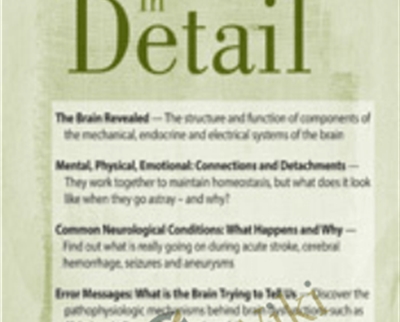The Brain in Detail – Sean G. Smith
The Brain in Detail – Sean G. Smith Download. Most of us learned our anatomy, physiology, and pathophysiology in school, where we were focused primarily on…
Original price was: $199.99.$56.00Current price is: $56.00.
Unlock your potential with the The Brain in Detail – Sean G. Smith course for only Original price was: $199.99.$56.00Current price is: $56.00. at WSOLib.com! Discover our vast library of over 60,000 downloadable digital courses across Hypnosis and NLP. Get expert-guided, self-paced learning and save over 80% compared to retail prices. Transform your skills today!
Salepage link: At HERE. Archive:
- The Brain Revealed — The structure and function of components of the mechanical, endocrine and electrical systems of the brain
- Mental, Physical, Emotional: Connections and Detachments — They work together to maintain homeostasis, but what does it look like when they go astray – and why?
- Common Neurological Conditions: What Happens and Why — Find out what is really going on during acute stroke, cerebral hemorrhage, seizures and aneurysms
- Error Messages: What is the Brain Trying to Tell Us — Discover the pathophysiologic mechanisms behind brain dysfunctions such as Alzheimer’s disease, Parkinson’s, and depression
Did you know that there may be permanent damage to the brain during TIA?
Or, wonder what exactly your neuro checks assess?
Or, become intimidated by caring for patients with neurological problems?
If you have a hard time explaining to your patients about why their heart disease is a risk factor for stroke, or how shrugging their shoulders and sticking out their tongues assesses their brain function, or what to watch for as signs of adverse effects of medications, then you need to go back to the basics with the help of a program that can make the information easy and understandable.
Most of us learned our anatomy, physiology, and pathophysiology in school, where we were focused primarily on passing the class. We memorized, we studied, but we quickly forgot.
You learn differently now. With years of experience, your brain has learned to classify your professional information into “file folders” based on your clinical experiences. Now, when you go back to learn these concepts, your brain will put the information into the correct “folder” to use the next time you encounter a patient with that problem. In other words, you will retain the information now that you have a way to organize it.
Attend this program and gain the essential concepts of neurological anatomy, physiology, and pathophysiology that will help you find patient complications faster and respond to them more appropriately. In addition:
- You will communicate more effectively with physicians and your peers
- You will feel more confident
- You will provide safer and more effective care
You don’t want to miss this exciting and applicable program to help improve outcomes and take your healthcare practice to the next level!
OUTLINE
The Brain Revealed — The structure and function of components of the mechanical, endocrine and electrical systems of the brain
Anatomy
- Life of a neuron
- Brain structure
- Spinal cord
- Peripheral Nervous System
- Autonomic Nervous System
- Aging and the Nervous System
Assessment
- Cranial Nerves
- Motor Function
- DTRs
- Levels of Consciousness
- Intracranial Pressure
Diagnostic Tests
- Lumbar Puncture
- CAT/MRI
- Angiogram
- EEG
Mental, Physical, Emotional: Connections and Detachments — They work togetherto maintain homeostasis; but what does itlook like when they go astray – and why?
Spinal Disorders
- Herniated Disc
- Spinal Stenosis
- Spinal Cord Injury
- Degenerative Neuromuscular Disorders
- Huntington’s Chorea
- Multiple Sclerosis
- Myasthenia Gravis
- Amytropic Lateral Sclerosis
- Guillain-Barré Syndrome
Cranial Nerve Disorders
- Trigeminal Neuralgia
- Bell’s Palsy
- Ménière’s Disease
Common Neurological Conditions: What Happens and Why
Central Nervous System Disorders
- Headaches
- Cerebral Vascular Disorders: TIA and Stroke Aneurysms
- Seizure Disorders
- Traumatic Brain Injuries
- Brain Tumors
- Effects of Alcohol and Alcoholism on the Brain
Error Messages: What is the Brain Trying to Tell Us?
- Dementias
- Parkinson’s Disease
- Depression
OBJECTIVES
- Define the anatomy and physiology of the neurological system and how this manifests in physical symptoms.
- Identify neurologic assessment modalities and the connection between how the brain works and the visual assessment.
- Categorize interventions and strategies for patients with traumatic brain injury based on the pathophysiological process and the long-term effects from these injuries.
- Describe how chemical imbalances and impulses create disorders such as dementias and Parkinson’s disease.
- Describe the best method for patient education based upon the knowledge of the pathophysiology of the most common neurological conditions.
Secure your future with the The Brain in Detail – Sean G. Smith course at WSOLib.com! Gain lifetime access to expertly curated content, empowering your career and personal development.
- Lifetime Access: Enjoy unlimited access to your digital courses.
- Huge Savings: Prices are consistently up to 80% lower than original sales pages.
- Secure Transactions: Shop with confidence using our trusted payment methods.
- Actionable Knowledge: Acquire real-world skills from diverse topics.
- Instant Delivery: Start learning immediately after purchase.
- Device Flexibility: Access your courses on desktop, mobile, or tablet.
Begin your learning journey with WSOLib.com!
Specification: The Brain in Detail – Sean G. Smith
|
User Reviews
Only logged in customers who have purchased this product may leave a review.





There are no reviews yet.